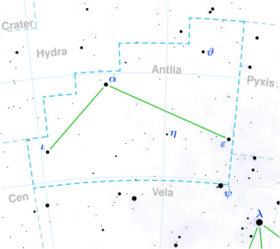Astronomy:HD 90132
| Observation data Epoch J2000.0 Equinox (celestial coordinates) | |
|---|---|
| Constellation | Antlia |
| Right ascension | 10h 23m 29.29608s[1] |
| Declination | −38° 00′ 35.4255″[1] |
| Apparent magnitude (V) | 5.33±0.01[2] |
| Characteristics | |
| Spectral type | A8 V[3] |
| B−V color index | +0.25[4] |
| Astrometry | |
| Radial velocity (Rv) | 17±4.2[5] km/s |
| Proper motion (μ) | RA: −158.833[1] mas/yr Dec.: −53.705[1] mas/yr |
| Parallax (π) | 24.2034 ± 0.0725[1] mas |
| Distance | 134.8 ± 0.4 ly (41.3 ± 0.1 pc) |
| Absolute magnitude (MV) | +2.25[6] |
| Details | |
| Mass | 1.69±0.27[7] M☉ |
| Radius | 1.87±0.87[7] R☉ |
| Luminosity | 9.79±0.06[8] L☉ |
| Surface gravity (log g) | 4.15[9] cgs |
| Temperature | 7,737±263[9] K |
| Metallicity [Fe/H] | −0.13[10] dex |
| Rotational velocity (v sin i) | 270[11] km/s |
| Age | 70[12] Myr |
| Other designations | |
| Database references | |
| SIMBAD | data |
HD 90132 (HR 4086) is a solitary[14] white hued star located in the southern constellation Antlia. It has an apparent magnitude of 5.33,[2] making it one of the brighter members of this generally faint constellation. The star is relatively close at a distance of 135 light years[1] but is receding with a heliocentric radial velocity of 17 km/s.[5]
HD 90132 has a stellar classification of A8 V,[3] indicating that it is an ordinary A-type main-sequence star. At present it has 1.69 times the mass of the Sun and 1.87 times the radius of the Sun.[7] Despite a young age of 70 million years,[12] the star has a lower surface gravity than expected.[9] This is due to the equator being 18% larger than the poles,[15] which is due to a high projected rotational velocity of 270 km/s.[11] Nevertheless, it shines with a luminosity of 9.8 solar luminosity[8] from its photosphere at an effective temperature of 7,737 K.[9] HD 90132 is slightly metal deficient with a metallicity 74% that of Sun.[10]
This star was observed for infrared excess suggesting the presence of a circumstellar disk, but as of 2017 no excess have been found.[16]
References
- ↑ 1.0 1.1 1.2 1.3 1.4 Brown, A. G. A. (2021). "Gaia Early Data Release 3: Summary of the contents and survey properties". Astronomy & Astrophysics 649: A1. doi:10.1051/0004-6361/202039657. Bibcode: 2021A&A...649A...1G. Gaia EDR3 record for this source at VizieR.
- ↑ 2.0 2.1 Høg, E.; Fabricius, C.; Makarov, V. V.; Urban, S.; Corbin, T.; Wycoff, G.; Bastian, U.; Schwekendiek, P. et al. (March 2000). "The Tycho-2 catalogue of the 2.5 million brightest stars". Astronomy and Astrophysics 355: L27–L30. ISSN 0004-6361. Bibcode: 2000A&A...355L..27H.
- ↑ 3.0 3.1 Houk, N. (1982). Michigan Catalogue of Two-dimensional Spectral Types for the HD stars. Volume_3. Declinations −40° to −26°. Bibcode: 1982mcts.book.....H.
- ↑ Johnson, H. L.; Mitchell, R. I.; Iriarte, B.; Wisniewski, W. Z. (1966). "UBVRIJKL Photometry of the Bright Stars". Communications of the Lunar and Planetary Laboratory 4: 99–110. Bibcode: 1966CoLPL...4...99J.
- ↑ 5.0 5.1 Gontcharov, G. A. (November 2006). "Pulkovo Compilation of Radial Velocities for 35 495 Hipparcos stars in a common system". Astronomy Letters 32 (11): 759–771. doi:10.1134/S1063773706110065. ISSN 1063-7737. Bibcode: 2006AstL...32..759G.
- ↑ Anderson, E.; Francis, Ch. (May 2012). "XHIP: An extended hipparcos compilation". Astronomy Letters 38 (5): 331–346. doi:10.1134/S1063773712050015. ISSN 1063-7737. Bibcode: 2012AstL...38..331A.
- ↑ 7.0 7.1 7.2 Stassun, Keivan G. et al. (9 September 2019). "The Revised TESS Input Catalog and Candidate Target List". The Astronomical Journal 158 (4): 138. doi:10.3847/1538-3881/ab3467. ISSN 0004-6256. Bibcode: 2019AJ....158..138S.
- ↑ 8.0 8.1 Brown, A. G. A. (August 2018). "Gaia Data Release 2: Summary of the contents and survey properties". Astronomy & Astrophysics 616: A1. doi:10.1051/0004-6361/201833051. Bibcode: 2018A&A...616A...1G. Gaia DR2 record for this source at VizieR.
- ↑ 9.0 9.1 9.2 9.3 David, Trevor J.; Hillenbrand, Lynne A. (12 May 2015). "The Ages of Early-type Stars: Strömgren Photometric Methods Calibrated, Validated, Tested, and Applied to Hosts and Prospective Hosts of Directly Imaged Exoplanets". The Astrophysical Journal 804 (2): 146. doi:10.1088/0004-637X/804/2/146. Bibcode: 2015ApJ...804..146D.
- ↑ 10.0 10.1 Netopil, Martin (4 May 2017). "Metallicity calibrations for dwarf stars and giants in the Geneva photometric system". Monthly Notices of the Royal Astronomical Society 469 (3): 3042–3055. doi:10.1093/mnras/stx1077. ISSN 0035-8711. Bibcode: 2017MNRAS.469.3042N.
- ↑ 11.0 11.1 Huang, Su-Shu (September 1953). "A Statistical Study of the Rotation of the Stars.". The Astrophysical Journal 118: 285. doi:10.1086/145751. ISSN 0004-637X. Bibcode: 1953ApJ...118..285H.
- ↑ 12.0 12.1 Vican, Laura (2 May 2012). "Age Determination for 346 Nearby Stars in the Herschel DEBRIS Survey". The Astronomical Journal 143 (6): 135. doi:10.1088/0004-6256/143/6/135. ISSN 0004-6256. Bibcode: 2012AJ....143..135V.
- ↑ "HD 90132". SIMBAD. Centre de données astronomiques de Strasbourg. http://simbad.u-strasbg.fr/simbad/sim-basic?Ident=HD+90132.
- ↑ Eggleton, P. P.; Tokovinin, A. A. (11 September 2008). "A catalogue of multiplicity among bright stellar systems". Monthly Notices of the Royal Astronomical Society 389 (2): 869–879. doi:10.1111/j.1365-2966.2008.13596.x. ISSN 0035-8711. Bibcode: 2008MNRAS.389..869E.
- ↑ van Belle, Gerard T. (14 March 2012). "Interferometric observations of rapidly rotating stars". The Astronomy and Astrophysics Review 20 (1): 51. doi:10.1007/s00159-012-0051-2. ISSN 0935-4956. Bibcode: 2012A&ARv..20...51V.
- ↑ Meshkat, Tiffany; Mawet, Dimitri; Bryan, Marta L.; Hinkley, Sasha; Bowler, Brendan P.; Stapelfeldt, Karl R.; Batygin, Konstantin; Padgett, Deborah et al. (21 November 2017). "A Direct Imaging Survey ofSpitzer-detected Debris Disks: Occurrence of Giant Planets in Dusty Systems". The Astronomical Journal 154 (6): 245. doi:10.3847/1538-3881/aa8e9a. Bibcode: 2017AJ....154..245M.
<ref> tag with name "Gould1879" defined in <references> is not used in prior text.
 |


